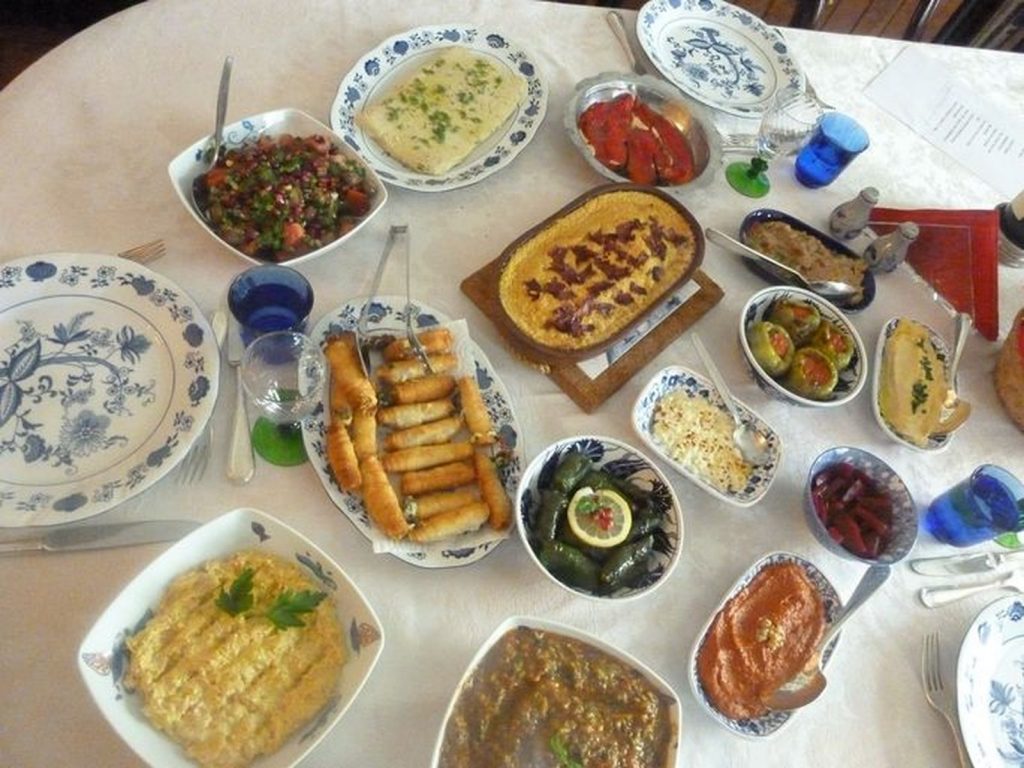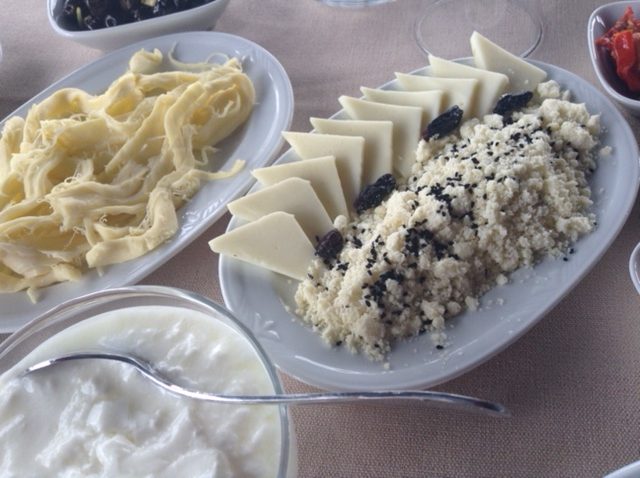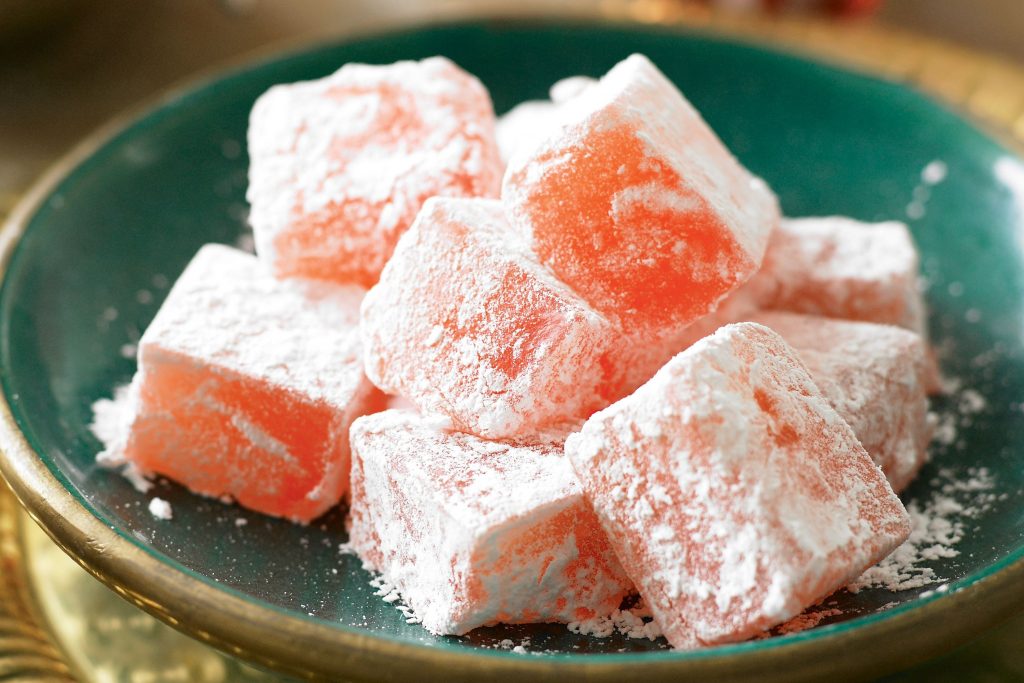MEZE
 Adaptable as nibbles, appetizers, snacks, or buffet spread, Turkish Meze and salads are delicious and infinite in variety- there are said to be over 40 dishes with aubergine alone.
Adaptable as nibbles, appetizers, snacks, or buffet spread, Turkish Meze and salads are delicious and infinite in variety- there are said to be over 40 dishes with aubergine alone.
The wonderful thing about Meze is that there are no rules. Often loosely translated as hors d’oeuvres, appetizer or snack, meze is so versatile that it can be all of these things and more.
The literal translation is “pleasant taste” and that is just what meze is – something tasty.
Traditionally, a table of meze was laid out to accompany Rakı, with the aim of achieving a “pleasent head” – to delight the palate, not fill the belly- and the relaxed enjoyment of meze was often accompanied by feelings of peace and serenity, even deep meditation. It was a custom enjoyed by men, most often traders and travellers, but over time it has evolved into a family affair. The meze table has never been regulated by time or order, just the unspoken understanding that the food should be served in small quantities, to be savoured and shared at a leisurely pace. With this in mind, many Turks like to eat meze with a glass of cloudy Rakı in the evening, when time is not pressing.
The most primitive form of meze is a small plate of cerez -a dainty serving of dried fruit such as white mulberries, plump olives with a squeeze of lemon, or even just a selection of nuts, roasted pumpkin seeds, salted sunflower seeds or leblebi (roasted chickpeas – the traditional accompaniment to raki).
Another simple form of meze is the popular Ezme, which consists of ingredients that are crushed, mashed, pounded, puréed or pressed into a paste to make the perfect consistency for scooping up with bread or using as a dip. Not all pounded or puréed dishes are called ezme though – some have their own names like Humus made with chickpeas, Tarama made with fish roe and Fava, a dish of puréed broad (fava) beans. A large meze spread can consist of a myriad of miniature foods, sometimes even miniature versions of a main dish, such as mini Anatolian pizzas ( fıstık lahmacun) or small meatballs (cızbız köfte).
Istanbul is home to some of the best Meze. In this vast vibrant city, almost every regional variation can be found somewhere, ranging from the simple spicy tastes of Anatolia to the more elaborate dishes from the Palace kitchens of the Ottoman Empire.
What Would a Turkish Breakfast Be Without Cheese?
 Visitors to Turkey are usually astonished when they learn that there are about 160 varieties of local cheese( peynir – in Turkish).They come in many shades of pale,from pearly white to creamy to crumbly.
Visitors to Turkey are usually astonished when they learn that there are about 160 varieties of local cheese( peynir – in Turkish).They come in many shades of pale,from pearly white to creamy to crumbly.
Few cultures feature cheese as a breakfast food so spectacularly as Turkey. When a Turk wakes up, he wants breakfast –even if it is well after noon. Visitors find cheese, olives, tomatoes,cucumbers and eggs laid out on the breakfast table with butter, honey, crusty bread and freshly brewed Turkish tea, this is the way a Turk begins his day.
Apart from breakfast cheese is used in cooking. Several cheeses melt well over pizzas, the unsalted lor is used in a rolled up fried pastry known as Sigara Böregi and in Antakya a local cream cream cheese melts into shredded pastry for a warm dessert known as künefe.
Turkish tost is the local derivative of a melted cheese sandwhich, compressed using a special waffle iron.Kaşer(kasher)cheese is the preferred choice here.
Some of the rich and rounded ewe’s milk cheeses make the most Turkish accompaniment to the country’s aniseed-based alcoholic drink, raki. Many small dishes are served as starters or with an aperitif and these are called mezeand resemble hors d’oeuvres. Ezine and Edirne cheeses are favoured,often with walnuts, with alcoholic drinks. Mushroom caps stuffed and grilled with Kaşer cheese make a tasty hot meze.
 Popular Turkish Cheese
Popular Turkish Cheese
Beyaz Peynir – ( White cheese) is a general term for the white crumbly ewe’s milk cheese that you will see most frequently and which every Turkish housewife has on her table.
It teams up well with black or green olives,wines ,grapes and apples. It is one of the popular cheese to serve with rak? and as part of a selection of meze.
Kaşer- This is Turkey’s best known and most popular cow’s milk cheese. It resembles a mild or medium Cheddar and they both have the same pale yellow colour and texture and gain their uniqaue flavour after being left on shelves to mature over several months. Taze Kaşer comes in commercially produced, vacuum packed rectangular logs but this is not the same as thereal thing which is Eski (old) Kaşer, produced in wheel shaped moulds,mostly around Van and Kars.The cheese seller cuts off as much as you require.The European side of Turkey also makes a Kaser calledTrakya Kaşer but the flavour is not as rounded as expansive as its Anatolian cousin.
The making of Kaşkaval cheese was a Jewish tradition and the Jewish residents of Trakya( European Turkey) were well known for their excellent cheeses. They produced cheese here well into the 1930’s. It is widely believed that the name of this cheese, Kaser , was an adaptation of the word Kashkaval which probably meant “kosher cheese”.
Lor – A soft white ,moist cheese which stays fresh for only a few days. It is often compared to Italian ricotta cheese. The best is made from ewe’s milk. The lack of distinct flavour makes it ideal for cooking or baking.
Tulum – This versatile cheese resembles Cheshire in its slightly mealy taste and crumbly texture. It is perfect with bread or toast also accompanies olives or pickles as an energizing snack.
 LOKUM – TURKISH DELIGHT
LOKUM – TURKISH DELIGHT
Invented in Anatolia in the 15th Century, lokum was originally a mixture of flour and either honey or grape molasses. In the 17th century, the introduction of refined ( loaf) sugar and more significantly starch to Ottoman lands enabled further modifications to production and flavour, and lokum became more widespread. After a traveler brought some lokum back to Europe in the 18th Century, this delicacy became popularly known as Turkish Delight. Today, the principle ingredients are water, sugar and starch as well as various fruit essences and nuts that are used to create a wide range of flavors and consistencies.
The syrup solution is heated in huge steam cookers to evaporate the excess liquid and gelatinize the cornstarch until reduced to an elastic mass with a maximum moisture content of %20. The sugar and other ingredients contribute to the eventual consistency of the lokum,as well as its sweetness and flavor. The hot mixture is poured in to a wooden tray or pan before being cut into pieces.
TURKISH WINES
Owing to its favourable climatic conditions and good soil a wide variety of grapes can be grown in Turkey. Visitors in Turkey are beginning to discover that there are some very good wines being made here. Turkey ranks sixth in world grape production. Although vineyards are spread all over the country, production is mainly concentrated in the Aegean, Mediterranean and Central Anatolian regions. Most Turkish wines are made from native wine grape varieties. Turkish wine producers are also using the native grapes in combination with European varieties to create high quality new wines with a new taste for the world wine market.
Some of the native grapes and their characteristics:
SULTANIYE
Produced in the town of Manisa and Denizli, situated in the Aegean province of Turkey bordering the Mediterranean province the grape is being produced at 200 meters above sea level and 1200 meters high in the town of Denizli. Sultaniye grape is light in texture, producing pleasant wines with fruit and spice aromas. It is highly recommended with all seafood, chicken and cheese as well as with all sweet pastries.
NARINCE
Produced in Tokat a town situated in North Central Anatolia region close to Black Sea province. Narince is a variatel wine with a yellow and greenish color. This elegant wine has flowery and strong fruit aromas. Goes well with seafood, chicken and cheese.
MISKET
The original name is Misket of Bornova.This variety is mostly grown in Izmir. The grains are medium size and round shaped.When ripe it has a red colour. It does not have too much must.This variety has a characteristical flavour and savour which consists of tropical fruits, flower, citrus, thyme anddaphne. Both dry and sweet Muscat wines are produced. Produces aromatic,live,light,easy to drink,clear golden yellow colored wines. Has basil,rose,mint,honey,bergamot,jasmine, melisa,orange blossom, daisy,grapefruit and melon aromas. Misket wine is a perfect aperitif wine. It is very coherent with neutral cheese,nuts,appetizers with sea food and slades that do not overshadow its aroma.
KALECIK KARASI
Produced from the grapes of Kalecik town in Ankara. The characteristics of this wine is burgundy red with bright purple hue, fresh red fruit at first followed by vanilla, banana, cherry, caramel aromas. Displays medium body and leaves velvet softness in the mouth. Kalecik Karası is goods for aging 8 to 10 years. Recommend either with red meat and cheese.
OKUZGOZU
Produced from the grapes of certificated Okuzgozu vineyard in Elaz?g near the Euphrates river in Southeastern region of Turkey. The characteristics of this wine is medium body, well balanced, good quality soft tannins, dark in color with purple hue, very in rich aromas of red fruits also soft touch of tobacco and leather notes. This special wine aging very well and good up to 8 years. Recommended with red meat, kebabs and steaks, spaghettis, pastas & cheese.
BOGAZKERE
Produced from the grapes of certificated Bogazkere vineyards of Elaz?g near the Tigris river in Southeastern region of Turkey. The characteristics of this wine is strong body, very enjoyable long finishing, dark red color with dark blue hue, very rich and strong aromas of dried red fruits, spices. Good for aging up to 10 years. Recommended with red meat kebabs, turkey, salmon and cheese. Especially eastern Anatolian cheddar or Gruyere cheese.
Wine is a culture gradually gaining more prestige in Turkey, and seems that the production and consumption have also increased in Turkey. There are efforts to establish its place among quality product in the global market. There are many wine boutiques in big cities. Moreover, some wine lovers have begun to produce their own wine at home.
SOME TURKISH WINES WORTH TASTING
Doluca Moscado
Doluca Özel Kav Beyaz
Doluca Antik 2000
Gülor Sangiovese 2001
Gülor Cabernet Sauvignon 2001
Gülor Cabernet Sauvignon Merlot
Gülor Sangiovese Montepulciano
Kavaklıdere Muscat
Kavaklıdere Carignan Alicante
Kavaklıdere Cabernet Sauvignon – Carignan
Kavaklıdere Emir Sultaniye (dömisek)
Kavaklıdere Selection 2000
Kavaklıdere Selection 1998
Melen Cabernet Sauvignon 2001
Melen Hamburg misketi
Pamukkale Şiraz
Sarafin Cabernet Sauvignon
Sarafin Fume Blanc
Sevilen Merlot 1999
Tekel Buzbağ







